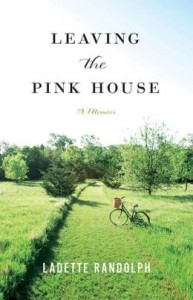Leaving the Pink House by Ladette Randolph
(University of Iowa Press, 2014)
 Even if Ladette had not been my editor at the University of Nebraska Press, and even if I had not read and admired all of her other award-winning books, especially Sandhills Ballad, which I have been teaching at UNK every semester, I still would have been interested in Leaving the Pink House. I am in the process of writing my own memoir/family history, and I knew it would be a good model. She told me that she had tried a unique way of organizing the book, and since my work in progress, “Placebound,” is rather eclectic, I pre-ordered the book so that I would have a copy while the ink was still damp.
Even if Ladette had not been my editor at the University of Nebraska Press, and even if I had not read and admired all of her other award-winning books, especially Sandhills Ballad, which I have been teaching at UNK every semester, I still would have been interested in Leaving the Pink House. I am in the process of writing my own memoir/family history, and I knew it would be a good model. She told me that she had tried a unique way of organizing the book, and since my work in progress, “Placebound,” is rather eclectic, I pre-ordered the book so that I would have a copy while the ink was still damp.
Since I was most interested in the structure of Leaving the Pink House, I will start there. Ladette begins her memoir with a description of the trip that she and her husband took to look at a farmhouse on an acreage outside of Lincoln, Nebraska, to fulfill her husband’s dream of living in the country. They had been searching for some time, and each dilapidated or poorly remodeled house made the prospect of a rural resettlement seem unattainable. The remainder of the first part of this chapter describes the decision to purchase their “dream house.” Here Ladette sets up the unifying idea for her book: “I best understand life through the houses where I have lived” (2). The second half of the chapter flashes back to her childhood, focusing on the house where she grew up in Custer County, Nebraska, and some family history.
These first chapters serve as templates for those that will follow. Alternating chapters detail the month by month process of remodeling the Randolphs’ country home followed by chapters that flash back to the different houses in which Randolph has lived that narrate her own and her family’s history. The last chapter ties both story lines together by aptly documenting the couple leaving the pink house, auctioning unwanted household furniture and goods, and moving to the country. The use of houses, past, present, and future, serve effectively to achieve thematic and structural coherence and unity.
What interested me next about the memoir was how Randolph would describe painful moments in her past, particularly her divorce from her second husband (her first husband was killed tragically in an automobile accident). Would she follow the tell-all example of Kim Barnes’s Hunger for the World, Jeanette Walls’s The Glass Castle, or Mary Karr’s The Liar’s Club? Thankfully, no. She simply titles the chapter, “House of Pain,” and begins with these lines: “I knew the precise moment I should have left my second marriage and didn’t” (144). She then describes how excited her husband had been after he had jogged for ten miles on a new trail near the hospital while she was in surgery and recovering in intensive care. She briefly describes an incident with an injured sparrow as well the time her husband left her and their baby home alone with three homeless, male strangers. She also flashes back to the scene in another hospital when she has just been told that her first husband was dead. Randolph stays in that marriage twelve more years, and ends the chapter philosophically, writing, “But I can’t leave it there, on such a sour note, such a despairing analogy, for it’s not like that at all. There is a happy ending, there really is. Time passes. We endure.” Her final sentence in the chapter concludes, “And with time I’ve also learned this lesson: gratitude is the sum of what you have lost and in some way found again” (154). Randolph transcended the dirty laundry and discovered meaning from her pain. Less can be more. This is something I need to remember in narrating my own story.
flashes back to the scene in another hospital when she has just been told that her first husband was dead. Randolph stays in that marriage twelve more years, and ends the chapter philosophically, writing, “But I can’t leave it there, on such a sour note, such a despairing analogy, for it’s not like that at all. There is a happy ending, there really is. Time passes. We endure.” Her final sentence in the chapter concludes, “And with time I’ve also learned this lesson: gratitude is the sum of what you have lost and in some way found again” (154). Randolph transcended the dirty laundry and discovered meaning from her pain. Less can be more. This is something I need to remember in narrating my own story.
Professional writers advise wannabees to look to other texts in the genre as models. Leaving the Pink House is a memoir/family history that I would suggest everyone read, not only for the unique structure, the smooth transitions between the past and present, dreams and reality, and the flawless style, but also for Randolph’s honesty, compassion, and restraint in recounting her life. “Sometimes the most obvious truths are elusive” (225), Randolph writes in the final chapter, but she was able to capture them for us in this unforgettable memoir.